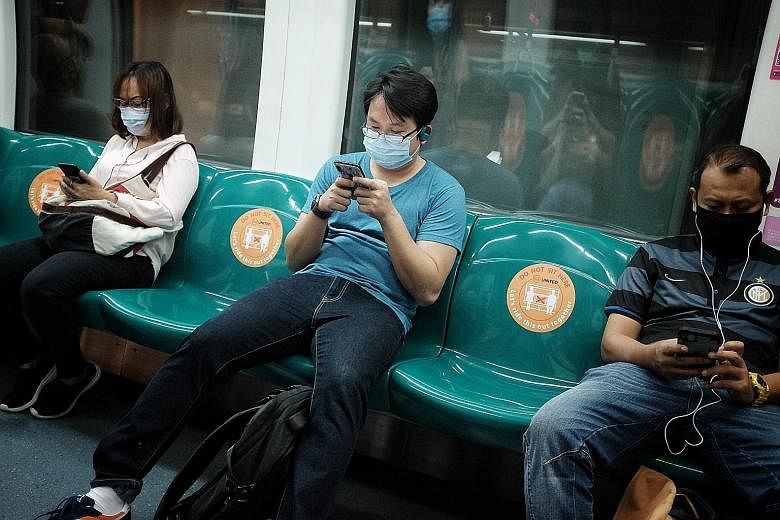All trains, train stations, buses, bus stops and interchanges will be progressively marked with safe distancing stickers, the Land Transport Authority (LTA) said yesterday, the third day of heightened measures to combat the Covid-19 outbreak.
Standing spaces and seats that should be avoided will be marked out. "Commuters should adhere to the spaces that are demarcated, to maintain safe distances from others when commuting," the LTA said.
Transport ambassadors and bus captains, together with LTA's enforcement officers, will help to see to this. They will limit the number of passengers entering train stations and buses, for instance.
The transport ambassadors, who include former taxi drivers and aviation crew, will be deployed "progressively".
About 100 have already been deployed at selected MRT stations this week, an LTA spokesman said. More will join them in the coming weeks.
Thermal scanners will also be deployed at selected MRT stations to provide an additional layer of screening before commuters enter the public transport network.
Commuters who are detected to be having a fever will not be allowed to enter, and will be asked to seek medical attention at the nearest clinic immediately. The first stations to have scanners will be Serangoon and Tiong Bahru.
The LTA said: "We would like to remind all commuters to be socially responsible. During this period when the elevated set of safe distancing measures are in force, everyone is advised to stay at home and avoid unnecessary commutes.
"Those who need to travel for essential purposes should put on a reusable face mask... and refrain from crowding. They should also follow the instructions given by transport ambassadors and LTA enforcement officers."
Observers said the distancing measures should be feasible now that public transport ridership has plunged. Before the elevated distancing measures kicked in this week, bus and rail ridership had already halved because many people were working from home.
Checks by The Straits Times on Monday revealed significantly emptier MRT trains during the morning peak. Asked how well he thinks distancing measures will work on public transport, Singapore University of Social Sciences associate professor Walter Theseira said: "The most important change to enable safe distancing was the fall in commuter travel.
"As long as commuter passenger volume is low enough, it should naturally work - in the first instance, nobody wants to sit next to someone else if there are empty seats. With Covid-19, people have even less reason to sit near others."
But he reckons there might also be sporadic challenges. "I think the main challenge will be if there are any localised peaks in demand.
"For example, if an essential factory or facility changes shift. Then, to maintain safe distancing, transport operator staff may have to forbid some passengers from boarding. That would probably make commuters quite unhappy. That sort of operational challenge will have to be worked out."
National University of Singapore transport researcher Lee Der-Horng said the measures "will definitely help".
"Safe distancing should be strictly enforced across all modes of public transport in conjunction with mandatory mask wearing. In China, MRT stations and bus interchanges are all equipped with thermal scanners.
"In Guangzhou, what they are doing now is to upgrade smart card readers with thermal scanning function to spot feverish passengers."
Dr Lee added that in many Chinese cities, a commuter's identity must be scanned before he boards a bus or train. This, he said, enables easy tracing should a confirmed case be identified.












